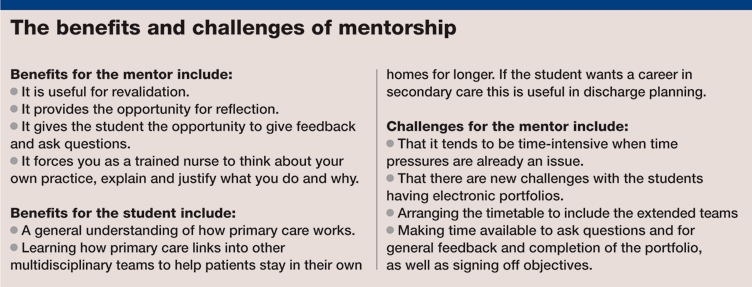How to become… a training practice

Susan Wallis gives a guide to setting up a training practice
General practice is a different learning environment to the one that students may be used to in a hospital ward. I have been a practice nurse since 2003, apart from a couple of years in secondary care. When I came back to Bradford’s Leylands Medical Centre, I was lucky to become a nurse manager. I work alongside three other practice nurses and two healthcare assistants in our two-centre, 14,000-patient practice.
When I returned to Bradford from secondary care in 2011, the centre was only taking student nurses for one or two days out of their community nursing placement and not directly into practice nursing placements. Therefore their experience of practice nursing was limited. University nursing degrees currently offer students six clinical placements over three years and remain secondary care-led, which means that the reality is that less than 20% of pre-registration nursing students will be offered a practice nursing placement as part of their community placement option.
Soon after I returned we were approached by the Bradford hub of the advanced training practice scheme (ATP). The hub’s three practice managers, as well as a retired practice manager and admin support had discovered that there was simply not a pot of highly-skilled practice nurses out there waiting to be offered jobs, so it came to us for help. Like many other clinical commissioning groups (CCGs), we were paying no attention to practice growth or changes in role and responsibilities for practice nursing teams, as well as no consideration to other workforce issues such as retirement.
At the time, many of the student nurses the ATP team had seen in general practice were working alongside the district nursing team. The team’s understanding of what a practice nurse did was limited to the baby or diabetes clinic. They were not given the opportunity to spend more time with the practice nursing team to see first-hand exactly what they did. The ATP’s desire was to offer as many student nurses in Bradford the chance to have a practice nursing placement and not just a community nursing placement, which is very different. I joined the ATP as nurse lead in 2015 and we are now up to 31 spokes (practices who take pre-registration undergraduate nurses) in Bradford. We are able to offer 50 placements this year.
Related Article: NHS plan delivery must equip and empower nurses, midwives and nursing associates
In 2011, to take pre-registration students we needed a qualified mentor – I was the only one at the time. We now have three mentors and a general practice nurse (GPN) ready nurse, who joined us in October last year. The GPN ready scheme is offered by Health Education England in Yorkshire and Humber to fund additional learning development for new nurse registrants in their first two years in general practice. Our GPN ready nurse will do her mentor training in the second year of her preceptorship. In my first practice nurse role, I had mentored secondary care students and a healthcare assistant in her Open University course. But when I joined the Bradford team, although it is a training practice, they were not taking student nurses from the University of Bradford. To rejoin the mentor register I had to do a half-day update.
The practice is audited by the University of Bradford. A learning and development agreement has to be signed between the ATP scheme and the practice. Then the university allocates a student. Placement length can range from six to 12 weeks.
The NMC states that the student must spend 40% of the time in practice working alongside their mentor. Apart from that they should be encouraged to spend time with the extended practice team, including receptionists, admin staff, GPs, advanced nurse practitioners, other practice nurses, healthcare assistants, district nurses, as well as physios, midwives, health visitors, dietitians, counsellors and any other multidisciplinary teams who offer services at the surgery. If a student nurse is able to do this they are guaranteed a full primary care experience.
However, the entire team needs to agree. For us, as we were already a training practice taking GP registrars, we all agreed to do it.
When a student nurse first arrives, we provide them a placement handbook, which explains our opening hours, a little about our practice population, who we are and what they should expect to experience while with us. I feel it is important to emphasise that it is a learning placement rather than a doing placement.
Depending where the student is in their training their knowledge about general practice and long-term condition management may be limited. It is important to realise that not every student wants to be a practice nurse and will likely have fixed ideas about what they want to do when they qualify or may already have a job lined up.
My final placement student last summer was in exactly that position. She had a job offer already in place and, prior to starting with us, had no intention of being
a practice nurse. She has since joined our team through the GPN ready scheme.
The advantages of taking on a student nurse include being able to pass on some of the expertise you have accrued over the years. One student told me that what she had learnt while out on placement with me about hypertension management and type 2 diabetes would stay with her for the rest of her nursing career.
Related Article: NMC seeks nursing leader to oversee Code and revalidation reviews
There is a lot to be said about teaching student nurses how to look after the well adult with chronic disease that will allow them to know more about how to look after the unwell adult with the same disease. To understand what can go wrong, why it happens, how it can be avoided and what needs to be done to get them back on track.
As mentors and experienced nurses we all have a duty of care to share what we know with the nurses of the future. As secondary care services become even more saturated there will continue to be more pressure on primary care to keep people with long-term conditions in their own homes, so practice nursing can be a career for life.
There is so much to learn and things are always changing. As practices struggle to recruit GPs and more long-term condition management and extended skills are passed on to the nursing team, including healthcare assistants, the overall structure of general practice looks set to change.

Susan Wallis is a nurse manager at Leylands Medical Centre in Bradford
Related Article: Tell us what practice nursing means to you and potentially win £1,000
References
1 Nursing and Midwifery Council. Standards to support learning and assessment in practice. London;NMC:2008
2 Nursing and Midwifery Council. ‘Practice Effectively’ in Revised Code for Nurses and Midwives. London;NMC:2015

See how our symptom tool can help you make better sense of patient presentations
Click here to search a symptom


When a student nurse first arrives, we provide them a placement handbook, which explains our opening hours, a little about our practice population, who we are and what they should expect to experience while with us.



